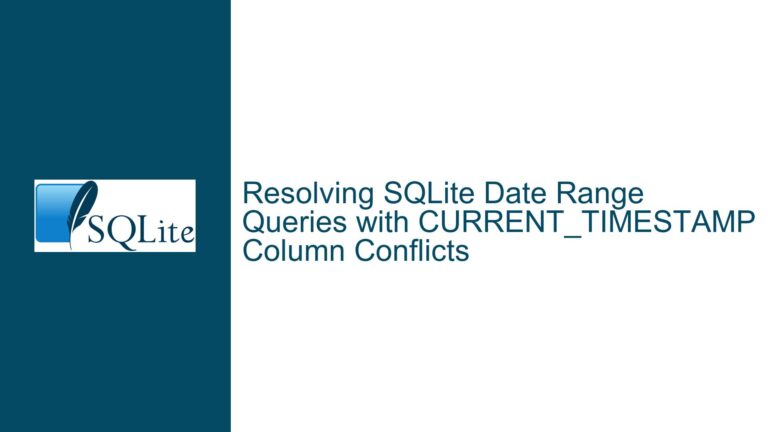NULL Comparisons and Three-Valued Logic in SQLite
Issue Overview: Why NULL = NULL Evaluates to False in SQLite
In SQLite, the comparison NULL = NULL does not yield true as one might intuitively expect. Instead, it evaluates to NULL, which in the context of conditional expressions like IIF or CASE, is treated as false. This behavior is rooted in the concept of three-valued logic, a fundamental aspect of SQL that distinguishes it from traditional binary logic. Understanding why NULL = NULL is not true requires a deep dive into the nature of NULL, the principles of three-valued logic, and how SQLite handles these concepts in its implementation.
The confusion often arises because NULL is not a value in the traditional sense. It represents the absence of a value or an unknown value. In SQL, NULL is a marker that indicates missing or inapplicable data. When you attempt to compare two NULL values using the equality operator (=), the result is not true or false but NULL. This is because, from a logical standpoint, you cannot definitively say that two unknown values are equal. They might be equal, or they might not be—there is no way to know for sure. Therefore, SQLite (and all SQL-compliant databases) adheres to the principle that NULL = NULL evaluates to NULL.
This behavior is particularly evident when using conditional functions like IIF or CASE. For example, the query SELECT IIF(NULL = NULL, 'ok', 'err') returns 'err' because the condition NULL = NULL evaluates to NULL, which is treated as false in the context of the IIF function. This can be counterintuitive for those accustomed to binary logic, where a comparison between two identical entities would typically return true.
Possible Causes: The Role of Three-Valued Logic and NULL Semantics
The core issue stems from the implementation of three-valued logic in SQL, which includes true, false, and unknown (represented by NULL). In traditional binary logic, every statement is either true or false. However, SQL introduces a third possibility: unknown. This is necessary because databases often deal with incomplete or missing data, and NULL serves as a placeholder for such scenarios.
When you compare two NULL values, the result is unknown because the database cannot determine whether two missing or unknown values are equal. This is a deliberate design choice in SQL, and it aligns with the principles of three-valued logic. The SQL standard (specifically SQL-92) mandates this behavior, and SQLite adheres to it. Therefore, NULL = NULL evaluates to NULL, not true.
Another factor contributing to this behavior is the way SQLite handles NULL in conditional expressions. Functions like IIF and CASE treat NULL as false when evaluating conditions. This is because, in the context of these functions, a condition must be definitively true for the corresponding action to be taken. If the condition evaluates to NULL, it is treated as false, and the alternative action is executed. This is why the query SELECT IIF(NULL = NULL, 'ok', 'err') returns 'err'.
It’s also worth noting that the IS operator in SQLite is specifically designed to handle NULL comparisons. Unlike the equality operator (=), which returns NULL when comparing NULL values, the IS operator returns true when both operands are NULL. This is because the IS operator is explicitly designed to check for NULL values, and it follows different rules than the equality operator. For example, the query SELECT IIF(NULL IS NULL, 'ok', 'err') correctly returns 'ok' because the IS operator recognizes that both operands are NULL.
Troubleshooting Steps, Solutions & Fixes: Proper Handling of NULL Comparisons in SQLite
To avoid confusion and ensure correct behavior when working with NULL values in SQLite, it’s essential to understand the proper techniques for comparing NULL values and handling them in conditional expressions. Here are some key strategies:
Use the
ISOperator for NULL Comparisons: When comparing a column or expression toNULL, always use theISoperator instead of the equality operator (=). TheISoperator is specifically designed to handleNULLvalues and will returntrueif both operands areNULL. For example, instead of writingSELECT IIF(NULL = NULL, 'ok', 'err'), you should writeSELECT IIF(NULL IS NULL, 'ok', 'err'). The latter query will return'ok'as expected.Understand the Behavior of Conditional Functions: When using functions like
IIForCASE, be aware that they treatNULLasfalsewhen evaluating conditions. If you need to check forNULLvalues within these functions, use theISoperator. For example, if you want to check whether a columncolumn_nameisNULLand return a specific value if it is, you should writeSELECT IIF(column_name IS NULL, 'ok', 'err').Avoid Using NULL in Equality Comparisons: As a general rule, avoid using the equality operator (
=) to compare values that might beNULL. Instead, use theISoperator or handleNULLvalues explicitly in your queries. For example, if you want to compare two columnscolumn1andcolumn2that might containNULLvalues, you should writeSELECT IIF(column1 IS NULL AND column2 IS NULL, 'ok', 'err')instead ofSELECT IIF(column1 = column2, 'ok', 'err').Consider Using COALESCE for Default Values: If you need to handle
NULLvalues by providing a default value, consider using theCOALESCEfunction. TheCOALESCEfunction returns the first non-NULLvalue in its list of arguments. For example, if you want to return a default value of0when a columncolumn_nameisNULL, you can writeSELECT COALESCE(column_name, 0). This approach ensures that your queries handleNULLvalues gracefully without requiring explicitNULLchecks.Document NULL Handling in Your Queries: When writing complex queries that involve
NULLvalues, consider adding comments or documentation to explain howNULLvalues are handled. This can help other developers (or your future self) understand the logic and avoid confusion. For example, you might write a comment like-- Use IS NULL to handle NULL values correctlynext to a query that checks forNULLvalues.Test Your Queries with NULL Values: When developing queries that involve
NULLvalues, always test them with various combinations ofNULLand non-NULLvalues to ensure they behave as expected. This is especially important when working with conditional functions likeIIForCASE, where the treatment ofNULLvalues can significantly impact the results.Leverage SQLite’s Documentation: SQLite’s documentation provides valuable insights into how
NULLvalues are handled in different contexts. Familiarize yourself with the relevant sections, such as the documentation on NULL Handling in SQLite and the IIF function. Understanding these resources can help you write more robust and accurate queries.
By following these strategies, you can effectively handle NULL values in SQLite and avoid common pitfalls associated with NULL comparisons. Remember that NULL is not a value but a marker for missing or unknown data, and it requires special handling in SQL queries. By using the IS operator, understanding the behavior of conditional functions, and testing your queries thoroughly, you can ensure that your SQLite queries handle NULL values correctly and produce the desired results.






